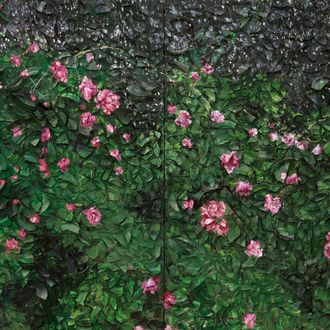
A few weeks back, Julian Schnabel caressed my ear, which is why I’m writing this piece, which partly is about meeting him and not being sure what there might be to write. I don’t know Julian Schnabel, though I know a bit about him, things like how his first wife said his son, Vito, was named after the Godfather, a movie he admired, and how Peter Schjeldahl once wrote that he “would be the Francis Ford Coppola of art if one could picture Coppola with all the studio heads, distributors, and other moguls on his side. He is in a state of total success …”, and how he himself once said he was “as close to Picasso as you’re going to get in this fucking life.” What else then could possibly be necessary or useful to say?
It was the end of February, a couple of days before the opening of a show of his New Plate Paintings. If you recall, he’d first been served man-size helping of fame and fortune off his old plate paintings, made almost 40 years ago now (related or not, he’d made a living as a chef before these mosaics of broken crockery became a smash). These were at his new gallery, Pace, which is also his old gallery, to which he’d returned in 2016 after 14 or so years at Gagosian, and they were getting the word out and offered time with him. Despite a perception that Schnabel had moved to making movies, which he’s quite good at, as well as furniture and the occasional interior-design project, yes, he is still assiduously churning out several different lines of great big paintings in his vast workshop on 11th Street.
Schnabel has a talent for fame, the absurd need it requires, the swagger it takes to be controversial, which is the inexhaustible, never-enough raw material required for fame, and much of the writing about him is imbued with the appreciation and resentment of him as a success monster. In 1988, Spy did a charticle comparing the narcissistic self-regard of his memoir and Trump’s, both new that year. It’s almost as if fame itself needs people like him to be able to continue as a going concern, this category of relentless public human, cursed in a way with this message to the world which is the vast reeking himness of him. And, therefore, he has been famous for many many years, and has been written about many, many times by this magazine and elsewhere. At 65, he’s become almost in his way a parody of the idea of what it takes to be written about in New York Magazine, which is more or less what my editors said when I brought up the idea of doing something about him in print.
Indeed, for your reading delectation, here are two good profiles of him from this magazine: Michael Stone’s, from 1992, which opens with an anecdote by his mother about how he jumped in a pool in Miami hotel when he was 4 to be with big kids, assuming he could swim when he could not, and John Homans’s from 2007, when Schnabel was already living in the Palazzo Chupi Venetian confection he’d built over his studio building in the West Village and had won the Best Director award at Cannes for his wonderful third film, The Diving Bell and the Butterfly.
Still, I was curious to meet him. I’d certainly seen him around before and still do — earlier this week, at the premiere for the Trainspotting sequel — and even, last year, endured the tropical gusts of his ego at a dinner a friend happened to take me to when I was in Los Angeles — the opening of a well-selected roundup of his work at Blum & Poe. (The show was called “Infinity on Trial.” The jury, at the dinner anyway, included Pam Anderson and LACMA’s Michael Govan.) I’d recently seen Hope, at the Whitney’s “Fast Forward: Paintings From the 1980s” show, which for some reason made me think of the Governor in The Walking Dead.
And so on the appointed day, I showed up: He was there, in his usual saggy, paint-smeared pants and brownish cable-knit sweater, his shoes untied, that knit cap squatting on his head, trying to decide which of the New Plate Paintings should be hung, and which should be not hung. How high, and how many, and where. What you would see from this angle or that. A shot list, of sorts. Schnabel was congenial and distracted that day, and not terribly interested in being interviewed, or maybe bored with the idea, which to tell you the truth I didn’t push too hard. When I mentioned I should ask a few pro forma “journalism questions,” he said, “You don’t have to.” And I kind of didn’t.
A note on the paintings themselves: They are decorative in a way that much of what he has made has often not been — green and blue with pink flowers on them, and inspired by roses growing in the cemetery near Van Gogh’s grave in Auvers-sur-Oise, France, which he’s been thinking about since he’s writing a script for a film about Van Gogh. Although they are of different sizes, some with beveled edges, and there are slight variances in the intensity of the green and the percentage of the blue and the density of the crockery, they in the end seemed to me to be shardy squares broken off a gigantic, sugary baked desert more than individual works. They were made in the last couple of years in various locations, though he told me that all of the crockery is sourced from the same place in New Jersey. Last year, one titled Rose Painting (Near Van Gogh’s Grave) I (2015) was hanging in Vito’s apartment in Palazzo Chupi — which is like a vertical version of the Corleone’s Tahoe compound, a family campanile right in the middle of the village — when our design director Wendy Goodman visited him there. The first were shown in his son Vito’s gallery in Switzerland.
And then here, for his Pace comeback. As Schnabel putters around and makes daubing updates to the sculpture out front, the gallery owner Arne Glimcher is there too, in a scarf. He’d told the Times that “Julian is a person who needs a lot of attention. And this is a gallery that pays attention to artists,” and he was here, giving it. I ask him what he thought of when he first saw these paintings, he chose another sacred French painting location: “Giverny. Monet’s garden. Such deep space: So different from the older plate paintings. These are illusory.”
Van Gogh was as inept at fame and success in his lifetime as Schnabel has proven talented at it. But Schnabel is 65 now: The Schnabel who made Hope, a more heroic than haunting vision of, from what I can tell, him, marching through the valley of the shadow of death — or maybe just being hassled on the street — from 1982, on display at the Whitney right now, is from when he started this journey to becoming this baronial, boundless man — now, perhaps, coming up on some sense of his limits. Others he’d known reached theirs early, including, long ago now, his tragic competitor for great genius of the time, Jean-Michel Basquiat. (According to Mary Boone, Schnabel left her gallery to work with Pace for the first time so he and Basquiat wouldn’t be in the same stable, though others put the ego tipping point with the arrival Eric Fischl, who right now shares a room with him at the Whitney show with a more pointed 1983 painting called A Visit To / A Visit From / The Island.) Despite or because of that rivalry he made a great film about Basquiat in 1996.
Later, after giving me a ride downtown and a quick tour of Palazzo Chupi, the grand, wonderful soundstage he’s made to live in, and after I pet his happy dog, a Ridgeback-bloodhound mix which will be perfect for hunting local big game after the apocalypse comes, he distracts me from the view out the big window facing east over the Village to draw my attention to one of the so-called “goat paintings” he’s been making, of a taxidermied goat posed in various heroic locations, a stuffed bunny strapped to the top of its head for some reason, obscure now even to him.
This one was based on an image of “George Washington accepting Cornwallis’s sword,” he says. “I superimposed [the goat] on the 1850 wallpaper and blew it up.” He actually owns the old stuffed goat. The bunny had been on it’s head for so long, like a set of malformed antlers, that “I forgot it was a bunny for a while,” he says. “When Mike Kelley died I made these paintings for him. Not these particular ones, but I started making the ones with the goats when he died.”
Oh, and the ear part? He was explaining how a rose is so much like an ear — I guess, my ear — and you know, I didn’t bother to make the Van Gogh joke, since in a way he’d made it himself.
Julian Schnabel: New Plate Paintings is on view at Pace Gallery until March 25.


